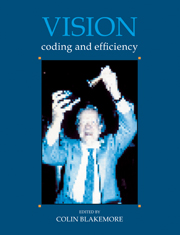Book contents
- Frontmatter
- Contents
- List of Contributors
- Preface
- Reply
- Acknowledgements
- Concepts of coding and efficiency
- Efficiency of the visual pathway
- Colour
- Brightness, adaptation and contrast
- Development of vision
- Depth and texture
- 26 Is there a single, most-efficient algorithm for stereopsis?
- 27 Binocular mechanisms in the normal and abnormal visual cortex of the cat
- 28 Viewing geometry and gradients of horizontal disparity
- 29 Texture discrimination: radiologist, machine and man
- Motion
- From image to object
- Index
29 - Texture discrimination: radiologist, machine and man
Published online by Cambridge University Press: 05 May 2010
- Frontmatter
- Contents
- List of Contributors
- Preface
- Reply
- Acknowledgements
- Concepts of coding and efficiency
- Efficiency of the visual pathway
- Colour
- Brightness, adaptation and contrast
- Development of vision
- Depth and texture
- 26 Is there a single, most-efficient algorithm for stereopsis?
- 27 Binocular mechanisms in the normal and abnormal visual cortex of the cat
- 28 Viewing geometry and gradients of horizontal disparity
- 29 Texture discrimination: radiologist, machine and man
- Motion
- From image to object
- Index
Summary
Introduction
Over the last few years we have developed machine algorithms for detection and discrimination of liver disease from diagnostic ultrasound scans of the liver (Wagner, Insana & Brown, 1986; Insana et al., 1986a; Insana et al, 1986b; Wagner, Insana & Brown, 1987). Several diffuse disease conditions are manifested through very subtle changes in the texture of the image. In these cases the machine algorithms significantly outperform expert clinical readers of the images (Garra et al., 1989). The discrimination of textures by the machine depends principally on an analysis and partitioning of second-order statistical features such as the autocorrelation and power spectral estimators. This finding has prompted us to investigate whether the human visual system might be more limited in its performance of such second-order tasks than it is for the wide range of first-order tasks where it scores so well.
At the beginning of this decade we learned how to use the words ‘well or good’ and ‘poorly or bad’ in the context of visual performance. We enjoyed a very fruitful collaboration with Horace Barlow through Arthur Burgess who split his sabbatical at that time between Horace Barlow's lab and ours (Burgess, Wagner, Jennings & Barlow, 1981; Burgess, Jennings & Wagner, 1982). From this collaboration we learned how instructive it is to compare the performance of the human visual system with that of the ideal observer from statistical decision theory. The latter introduces no fluctuations or sources of error beyond those inherent to the data that conveys the scene or image.
- Type
- Chapter
- Information
- VisionCoding and Efficiency, pp. 310 - 318Publisher: Cambridge University PressPrint publication year: 1991
- 1
- Cited by



